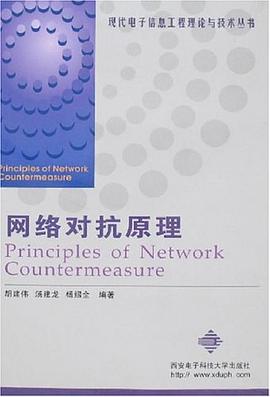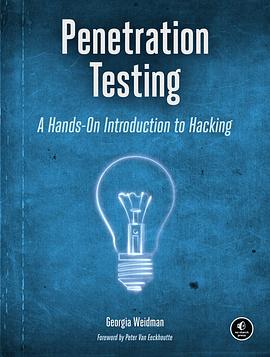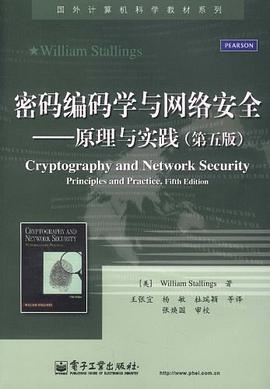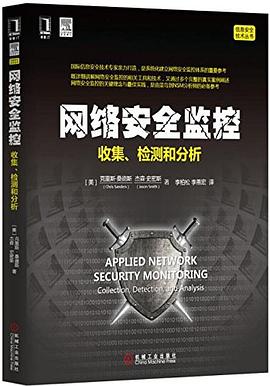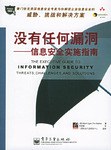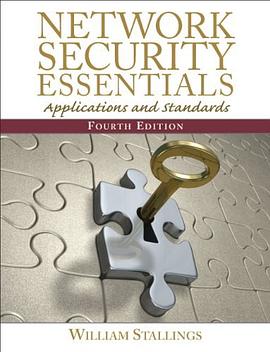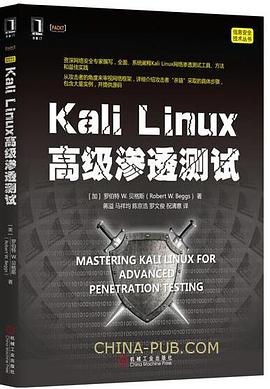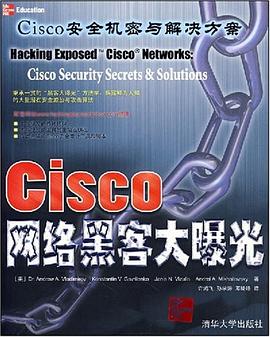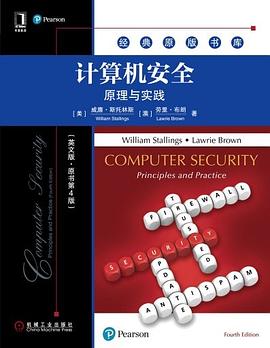

具体描述
本书是计算机安全领域的经典教材,系统介绍了计算机安全的方方面面。全书包括5个部分,第一部分介绍计算机安全技术和原理,涵盖了支持有效安全策略所必需的所有技术领域;第二部分介绍软件安全和可信系统,主要涉及软件开发和运行带来的安全问题及相应的对策;第三部分介绍管理问题,主要讨论信息安全与计算机安全在管理方面的问题,以及与计算机安全相关的法律与道德方面的问题;第四部分为密码编码算法,包括各种类型的加密算法和其他类型的密码算法;第五部分介绍网络安全,关注的是为在Internet上进行通信提供安全保障的协议和标准及无线网络安全等问题。
作者简介
William Stallings 博士,知名计算机图书作者,曾13次获得美国教材和学术专著作者协会颁发的年度最佳计算机科学教材奖。他的研究兴趣包括计算机网络、通信、安全、操作系统等,曾为多种计算机和操作系统设计并实现了基于TCP/IP和OSI的协议组。
Lawrie Brown 博士,澳大利亚国防大学信息技术与电子工程学院高级讲师。他的专业兴趣涉及通信安全、计算机系统安全以及密码学。
目录信息
第1章 概述23
1.1计算机安全的概念24
1.2威胁、攻击和资产31
1.3安全功能要求37
1.4基本安全设计原则39
1.5攻击面和攻击树43
1.6计算机安全策略46
1.7标准48
1.8关键术语、复习题和习题49
第一部分 计算机安全技术与原理
第2章 密码编码工具52
2.1用对称加密实现机密性53
2.2消息认证和散列函数59
2.3公钥加密67
2.4数字签名和密钥管理72
2.5随机数和伪随机数77
2.6实际应用:存储数据的加密79
2.7关键术语、复习题和习题80
第3章 用户认证85
3.1数字用户认证方法86
3.2基于口令的认证92
3.3基于令牌的认证104
3.4生物特征认证109
3.5远程用户认证114
3.6用户认证中的安全问题117
3.7实际应用:虹膜生物特征认证系统119
3.8案例学习:ATM系统的安全问题121
3.9关键术语、复习题和习题124
第4章 访问控制127
4.1访问控制原理128
4.2主体、客体和访问权131
4.3自主访问控制132
4.4实例:UNIX文件访问控制139
4.5基于角色的访问控制142
4.6基于属性的访问控制148
4.7身份、凭证和访问管理154
4.8信任框架158
4.9案例学习:银行的RBAC系统162
4.10关键术语、复习题和习题164
第5章 数据库与云安全169
5.1数据库安全需求170
5.2数据库管理系统171
5.3关系数据库173
5.4SQL注入攻击177
5.5数据库访问控制183
5.6推理188
5.7数据库加密190
5.8 数据中心安全194
5.9关键术语、复习题和习题200
第6章 恶意软件205
6.1恶意软件的类型207
6.2高级持续性威胁209
6.3传播-感染内容-病毒210
6.4传播-漏洞利用-蠕虫215
6.5传播-社会工程学-垃圾电子邮件、木马224
6.6载荷-系统损坏227
6.7载荷-攻击代理- zombie、bot229
6.8载荷-信息窃取-键盘ji录器、网络钓鱼、间die软件231
6.9 载荷-隐蔽-后门、rootkit233
6.10对抗手段236
6.11关键术语、复习题和习题242
第7章 拒绝服务攻击246
7.1 拒绝服务攻击247
7.2 洪泛攻击255
7.3 分布式拒绝服务攻击256
7.4 基于应用的带宽攻击258
7.5 反射攻击与放大攻击261
7.6 拒绝服务攻击防范265
7.7 对拒绝服务攻击的响应269
7.8 关键术语、复习题和习题270
第8章 入侵检测273
8.1 入侵者274
8.2 入侵检测278
8.3 分析方法281
8.4 基于主机的入侵检测284
8.5 基于网络的入侵检测289
8.6 分布式或混合式入侵检测295
8.7 入侵检测交换格式 297
8.8 蜜罐300
8.9 实例系统:Snort302
8.10 关键术语、复习题和习题306
第9章 防火墙与入侵防御系统310
9.1 防火墙的必要性311
9.2 防火墙的特征和访问策略312
9.3 防火墙的类型314
9.4 防火墙的布置320
9.5 防火墙的部署和配置323
9.6 入侵防御系统328
9.7 实例:一体化威胁管理产品332
9.8 关键术语、复习题和习题336
第二部分 软件和系统安全
第10章 缓冲区溢出341
10.1 栈溢出343
10.2 针对缓冲区溢出的防御364
10.3 其他形式的溢出攻击370
10.4 关键术语、复习题和习题377
第11章 软件安全379
11.1 软件安全问题380
11.2 处理程序输入384
11.3 编写安全程序代码395
11.4 与操作系统和其他程序进行交互400
11.5 处理程序输出413
11.6 关键术语、复习题和习题415
第12章 操作系统安全419
12.1 操作系统安全简介421
12.2 系统安全规划422
12.3 操作系统加固422
12.4 应用安全426
12.5 安全维护428
12.6 Linux/UNIX安全429
12.7 Windows安全433
12.8 虚拟化安全435
12.9 关键术语、复习题和习题443
第13章 云和IoT安全445
13.1 云计算446
13.2 云安全的概念454
13.3 云安全方法457
13.4 物联网466
13.5 IoT安全470
13.6 关键术语和复习题478
第三部分 管理问题
第14章 IT安全管理与风险评估480
14.1 IT安全管理481
14.2 组织的情境和安全方针484
14.3 安全风险评估487
14.4 详细的安全风险分析490
14.5 案例学习:银星矿业502
14.6 关键术语、复习题和习题507
第15章 IT安全控制、计划和规程510
15.1 IT安全管理的实施511
15.2 安全控制或保障措施511
15.3 IT安全计划520
15.4 控制的实施521
15.5 监视风险522
15.6 案例学习:银星矿业524
15.7 关键术语、复习题和习题527
第16章 物理和基础设施安全529
16.1 概述530
16.2 物理安全威胁531
16.3 物理安全的防御和减缓措施538
16.4 物理安全破坏的恢复541
16.5 实例:某公司的物理安全策略541
16.6 物理安全和逻辑安全的集成542
16.7 关键术语、复习题和习题548
第17章 人力资源安全550
17.1 安全意识、培训和教育551
17.2 雇用实践和策略557
17.3 电子邮件和Internet使用策略560
17.4 计算机安全事件响应团队561
17.5 关键术语、复习题和习题568
第18章 安全审计570
18.1 安全审计体系结构572
18.2 安全审计迹576
18.3 实现日志功能581
18.4 审计迹分析592
18.5 安全信息和事件管理596
18.6 关键术语、复习题和习题598
第19章 法律与道德问题600
19.1 网络犯罪和计算机犯罪601
19.2 知识产权605
19.3 隐私611
19.4 道德问题618
19.5 关键术语、复习题和习题624
第四部分 密码编码算法
第20章 对称加密和消息机密性627
20.1 对称加密原理628
20.2 数据加密标准633
20.3 高级加密标准635
20.4 流密码和RC4641
20.5 分组密码的工作模式644
20.6 密钥分发650
20.7 关键术语、复习题和习题652
第21章 公钥密码和消息认证656
21.1 安全散列函数657
21.2 HMAC663
21.3 认证加密666
21.4 RSA公钥加密算法669
21.5 Diffie-Hellman和其他非对称算法675
21.6 关键术语、复习题和习题679
第五部分 网络安全
第22章 Internet安全协议和标准682
22.1 安全E-mail和S/MIME683
22.2 域名密钥识别邮件标准686
22.3 安全套接层和传输层安全690
22.4 HTTPS697
22.5 IPv4和IPv6的安全性698
22.6 关键术语、复习题和习题703
第23章 Internet认证应用706
23.1 Kerberos707
23.2 X.509713
23.3 公钥基础设施716
23.4 关键术语、复习题和习题719
第24章 无线网络安全722
24.1 无线安全723
24.2 移动设备安全726
24.3 IEEE 802.11无线局域网概述730
24.4 IEEE 802.11i无线局域网安全736
24.5 关键术语、复习题和习题751
附录A 计算机安全教学项目和学生练习754
缩略语761
NIST和ISO文件列表762
参考文献764
在线章节和附录
第25章 Linux安全
第26章 Windows安全
第27章 可信计算与多级安全
附录B 数论的相关内容
附录C 标准和标准制定组织
附录D 随机数与伪随机数的生成
附录E 基于分组密码的消息认证码
附录F TCP/IP协议体系结构
附录G Radix-64转换
附录H 域名系统
附录I 基率谬误
附录J SHA-3
附录K 术语
Contents
Chapter 1 Overview 23
1.1 Computer Security Concepts 24
1.2 Threats, Attacks, and Assets 31
1.3 Security Functional Requirements 37
1.4 Fundamental Security Design Principles 39
1.5 Attack Surfaces and Attack Trees 43
1.6 Computer Security Strategy 46
1.7 Standards 48
1.8 Key Terms, Review Questions, and Problems 49
PART ONE COMPUTER SECURITY TECHNOLOGY AND PRINCIPLES 52
Chapter 2 Cryptographic Tools 52
2.1 Confidentiality with Symmetric Encryption 53
2.2 Message Authentication and Hash Functions 59
2.3 Public-Key Encryption 67
2.4 Digital Signatures and Key Management 72
2.5 Random and Pseudorandom Numbers 77
2.6 Practical Application: Encryption of Stored Data 79
2.7 Key Terms, Review Questions, and Problems 80
Chapter 3 User Authentication 85
3.1 Digital User Authentication Principles 86
3.2 Password-Based Authentication 92
3.3 Token-Based Authentication 104
3.4 Biometric Authentication 109
3.5 Remote User Authentication 114
3.6 Security Issues for User Authentication 117
3.7 Practical Application: An Iris Biometric System 119
3.8 Case Study: Security Problems for ATM Systems 121
3.9 Key Terms, Review Questions, and Problems 124
Chapter 4 Access Control 127
4.1 Access Control Principles 128
4.2 Subjects, Objects, and Access Rights 131
4.3 Discretionary Access Control 132
4.4 Example: UNIX File Access Control 139
4.5 Role-Based Access Control 142
4.6 Attribute-Based Access Control 148
4.7 Identity, Credential, and Access Management 154
4.8 Trust Frameworks 158
4.9 Case Study: RBAC System for a Bank 162
4.10 Key Terms, Review Questions, and Problems 164
Chapter 5 Database and Data Center Security 169
5.1 The Need for Database Security 170
5.2 Database Management Systems 171
5.3 Relational Databases 173
5.4 SQL Injection Attacks 177
5.5 Database Access Control 183
5.6 Inference 188
5.7 Database Encryption 190
5.8 Data Center Security 194
5.9 Key Terms, Review Questions, and Problems 200
Chapter 6 Malicious Software 205
6.1 Types of Malicious Software (Malware) 207
6.2 Advanced Persistent Threat 209
6.3 Propagation—Infected Content—Viruses 210
6.4 Propagation—Vulnerability Exploit—Worms 215
6.5 Propagation—Social Engineering—Spam E-mail, Trojans 224
6.6 Payload—System Corruption 227
6.7 Payload—Attack Agent—Zombie, Bots 229
6.8 Payload—Information Theft—Keyloggers, Phishing, Spyware 231
6.9 Payload—Stealthing—Backdoors, Rootkits 233
6.10 Countermeasures 236
6.11 Key Terms, Review Questions, and Problems 242
Chapter 7 Denial-of-Service Attacks 246
7.1 Denial-of-Service Attacks 247
7.2 Flooding Attacks 255
7.3 Distributed Denial-of-Service Attacks 256
7.4 Application-Based Bandwidth Attacks 258
7.5 Reflector and Amplifier Attacks 261
7.6 Defenses Against Denial-of-Service Attacks 265
7.7 Responding to a Denial-of-Service Attack 269
7.8 Key Terms, Review Questions, and Problems 270
Chapter 8 Intrusion Detection 273
8.1 Intruders 274
8.2 Intrusion Detection 278
8.3 Analysis Approaches 281
8.4 Host-Based Intrusion Detection 284
8.5 Network-Based Intrusion Detection 289
8.6 Distributed or Hybrid Intrusion Detection 295
8.7 Intrusion Detection Exchange Format 297
8.8 Honeypots 300
8.9 Example System: Snort 302
8.10 Key Terms, Review Questions, and Problems 306
Chapter 9 Firewalls and Intrusion Prevention Systems 310
9.1 The Need for Firewalls 311
9.2 Firewall Characteristics and Access Policy 312
9.3 Types of Firewalls 314
9.4 Firewall Basing 320
9.5 Firewall Location and Configurations 323
9.6 Intrusion Prevention Systems 328
9.7 Example: Unified Threat Management Products 332
9.8 Key Terms, Review Questions, and Problems 336
PART TWO SOFTWARE AND SYSTEM SECURITY 341
Chapter 10 Buffer Overflow 341
10.1 Stack Overflows 343
10.2 Defending Against Buffer Overflows 364
10.3 Other forms of Overflow Attacks 370
10.4 Key Terms, Review Questions, and Problems 377
Chapter 11 Software Security 379
11.1 Software Security Issues 380
11.2 Handling Program Input 384
11.3 Writing Safe Program Code 395
11.4 Interacting with the Operating System and Other Programs 400
11.5 Handling Program Output 413
11.6 Key Terms, Review Questions, and Problems 415
Chapter 12 Operating System Security 419
12.1 Introduction to Operating System Security 421
12.2 System Security Planning 422
12.3 Operating Systems Hardening 422
12.4 Application Security 426
12.5 Security Maintenance 428
12.6 Linux/Unix Security 429
12.7 Windows Security 433
12.8 Virtualization Security 435
12.9 Key Terms, Review Questions, and Problems 443
Chapter 13 Cloud and IoT Security 445
13.1 Cloud Computing 446
13.2 Cloud Security Concepts 454
13.3 Cloud Security Approaches 457
13.4 The Internet of Things 466
13.5 IoT Security 470
13.6 Key Terms and Review Questions 478
PART THREE MANAGEMENT ISSUES 480
Chapter 14 IT Security Management and Risk Assessment 480
14.1 IT Security Management 481
14.2 Organizational Context and Security Policy 484
14.3 Security Risk Assessment 487
14.4 Detailed Security Risk Analysis 490
14.5 Case Study: Silver Star Mines 502
14.6 Key Terms, Review Questions, and Problems 507
Chapter 15 IT Security Controls, Plans, and Procedures 510
15.1 IT Security Management Implementation 511
15.2 Security Controls or Safeguards 511
15.3 IT Security Plan 520
15.4 Implementation of Controls 521
15.5 Monitoring Risks 522
15.6 Case Study: Silver Star Mines 524
15.7 Key Terms, Review Questions, and Problems 527
Chapter 16 Physical and Infrastructure Security 529
16.1 Overview 530
16.2 Physical Security Threats 531
16.3 Physical Security Prevention and Mitigation Measures 538
16.4 Recovery from Physical Security Breaches 541
16.5 Example: A Corporate Physical Security Policy 541
16.6 Integration of Physical and Logical Security 542
16.7 Key Terms, Review Questions, and Problems 548
Chapter 17 Human Resources Security 550
17.1 Security Awareness, Training, and Education 551
17.2 Employment Practices and Policies 557
17.3 E-mail and Internet Use Policies 560
17.4 Computer Security Incident Response Teams 561
17.5 Key Terms, Review Questions, and Problems 568
Chapter 18 Security Auditing 570
18.1 Security Auditing Architecture 572
18.2 Security Audit Trail 576
18.3 Implementing the Logging Function 581
18.4 Audit Trail Analysis 592
18.5 Security Information and Event Management 596
18.6 Key Terms, Review Questions, and Problems 598
Chapter 19 Legal and Ethical Aspects 600
19.1 Cybercrime and Computer Crime 601
19.2 Intellectual Property 605
19.3 Privacy 611
19.4 Ethical Issues 618
19.5 Key Terms, Review Questions, and Problems 624
PART FOUR CRYPTOGRAPHIC ALGORITHMS 627
Chapter 20 Symmetric Encryption and Message Confidentiality 627
20.1 Symmetric Encryption Principles 628
20.2 Data Encryption Standard 633
20.3 Advanced Encryption Standard 635
20.4 Stream Ciphers and RC4 641
20.5 Cipher Block Modes of Operation 644
20.6 Key Distribution 650
20.7 Key Terms, Review Questions, and Problems 652
Chapter 21 Public-Key Cryptography and Message Authentication 656
21.1 Secure Hash Functions 657
21.2 HMAC 663
21.3 Authenticated Encryption 666
21.4 The RSA Public-Key Encryption Algorithm 669
21.5 Diffie-Hellman and Other Asymmetric Algorithms 675
21.6 Key Terms, Review Questions, and Problems 679
PART FIVE NETWORK SECURITY 682
Chapter 22 Internet Security Protocols and Standards 682
22.1 Secure E-mail and S/MIME 683
22.2 Domainkeys Identified Mail 686
22.3 Secure Sockets Layer (SSL) and Transport Layer Security (TLS) 690
22.4 HTTPS 697
22.5 IPv4 and IPv6 Security 698
22.6 Key Terms, Review Questions, and Problems 703
Chapter 23 Internet Authentication Applications 706
23.1 Kerberos 707
23.2 X.509 713
23.3 Public-Key Infrastructure 716
23.4 Key Terms, Review Questions, and Problems 719
Chapter 24 Wireless Network Security 722
24.1 Wireless Security 723
24.2 Mobile Device Security 726
24.3 IEEE 802.11 Wireless LAN Overview 730
24.4 IEEE 802.11i Wireless LAN Security 736
24.5 Key Terms, Review Questions, and Problems 751
Appendix A Projects and Other Student Exercises for Teaching Computer Security 754
A.1 Hacking Project 754
A.2 Laboratory Exercises 755
A.3 Security Education (SEED) Projects 755
A.4 Research Projects 757
A.5 Programming Projects 758
A.6 Practical Security Assessments 758
A.7 Firewall Projects 758
A.8 Case Studies 759
A.9 Reading/Report Assignments 759
A.10 Writing Assignments 759
A.11 Webcasts for Teaching Computer Security 760
Acronyms 761
List of NIST and ISO Documents 762
References 764
ONLINE CHAPTERS AND APPENDICES
Chapter 25 Linux Security
Chapter 26 Windows and Windows Vista Security
Chapter 27 Trusted Computing and Multilevel Security
Appendix B Some Aspects of Number Theory
Appendix C Standards and Standard-Setting Organizations
Appendix D Random and Pseudorandom Number Generation
Appendix E Message Authentication Codes Based on Block Ciphers
Appendix F TCP/IP Protocol Architecture
Appendix G Radix-64 Conversion
Appendix H The Domain Name System
Appendix I The Base-Rate Fallacy
Appendix J SHA-3Appendix K Glossary
· · · · · · (收起)
1.1计算机安全的概念24
1.2威胁、攻击和资产31
1.3安全功能要求37
1.4基本安全设计原则39
1.5攻击面和攻击树43
1.6计算机安全策略46
1.7标准48
1.8关键术语、复习题和习题49
第一部分 计算机安全技术与原理
第2章 密码编码工具52
2.1用对称加密实现机密性53
2.2消息认证和散列函数59
2.3公钥加密67
2.4数字签名和密钥管理72
2.5随机数和伪随机数77
2.6实际应用:存储数据的加密79
2.7关键术语、复习题和习题80
第3章 用户认证85
3.1数字用户认证方法86
3.2基于口令的认证92
3.3基于令牌的认证104
3.4生物特征认证109
3.5远程用户认证114
3.6用户认证中的安全问题117
3.7实际应用:虹膜生物特征认证系统119
3.8案例学习:ATM系统的安全问题121
3.9关键术语、复习题和习题124
第4章 访问控制127
4.1访问控制原理128
4.2主体、客体和访问权131
4.3自主访问控制132
4.4实例:UNIX文件访问控制139
4.5基于角色的访问控制142
4.6基于属性的访问控制148
4.7身份、凭证和访问管理154
4.8信任框架158
4.9案例学习:银行的RBAC系统162
4.10关键术语、复习题和习题164
第5章 数据库与云安全169
5.1数据库安全需求170
5.2数据库管理系统171
5.3关系数据库173
5.4SQL注入攻击177
5.5数据库访问控制183
5.6推理188
5.7数据库加密190
5.8 数据中心安全194
5.9关键术语、复习题和习题200
第6章 恶意软件205
6.1恶意软件的类型207
6.2高级持续性威胁209
6.3传播-感染内容-病毒210
6.4传播-漏洞利用-蠕虫215
6.5传播-社会工程学-垃圾电子邮件、木马224
6.6载荷-系统损坏227
6.7载荷-攻击代理- zombie、bot229
6.8载荷-信息窃取-键盘ji录器、网络钓鱼、间die软件231
6.9 载荷-隐蔽-后门、rootkit233
6.10对抗手段236
6.11关键术语、复习题和习题242
第7章 拒绝服务攻击246
7.1 拒绝服务攻击247
7.2 洪泛攻击255
7.3 分布式拒绝服务攻击256
7.4 基于应用的带宽攻击258
7.5 反射攻击与放大攻击261
7.6 拒绝服务攻击防范265
7.7 对拒绝服务攻击的响应269
7.8 关键术语、复习题和习题270
第8章 入侵检测273
8.1 入侵者274
8.2 入侵检测278
8.3 分析方法281
8.4 基于主机的入侵检测284
8.5 基于网络的入侵检测289
8.6 分布式或混合式入侵检测295
8.7 入侵检测交换格式 297
8.8 蜜罐300
8.9 实例系统:Snort302
8.10 关键术语、复习题和习题306
第9章 防火墙与入侵防御系统310
9.1 防火墙的必要性311
9.2 防火墙的特征和访问策略312
9.3 防火墙的类型314
9.4 防火墙的布置320
9.5 防火墙的部署和配置323
9.6 入侵防御系统328
9.7 实例:一体化威胁管理产品332
9.8 关键术语、复习题和习题336
第二部分 软件和系统安全
第10章 缓冲区溢出341
10.1 栈溢出343
10.2 针对缓冲区溢出的防御364
10.3 其他形式的溢出攻击370
10.4 关键术语、复习题和习题377
第11章 软件安全379
11.1 软件安全问题380
11.2 处理程序输入384
11.3 编写安全程序代码395
11.4 与操作系统和其他程序进行交互400
11.5 处理程序输出413
11.6 关键术语、复习题和习题415
第12章 操作系统安全419
12.1 操作系统安全简介421
12.2 系统安全规划422
12.3 操作系统加固422
12.4 应用安全426
12.5 安全维护428
12.6 Linux/UNIX安全429
12.7 Windows安全433
12.8 虚拟化安全435
12.9 关键术语、复习题和习题443
第13章 云和IoT安全445
13.1 云计算446
13.2 云安全的概念454
13.3 云安全方法457
13.4 物联网466
13.5 IoT安全470
13.6 关键术语和复习题478
第三部分 管理问题
第14章 IT安全管理与风险评估480
14.1 IT安全管理481
14.2 组织的情境和安全方针484
14.3 安全风险评估487
14.4 详细的安全风险分析490
14.5 案例学习:银星矿业502
14.6 关键术语、复习题和习题507
第15章 IT安全控制、计划和规程510
15.1 IT安全管理的实施511
15.2 安全控制或保障措施511
15.3 IT安全计划520
15.4 控制的实施521
15.5 监视风险522
15.6 案例学习:银星矿业524
15.7 关键术语、复习题和习题527
第16章 物理和基础设施安全529
16.1 概述530
16.2 物理安全威胁531
16.3 物理安全的防御和减缓措施538
16.4 物理安全破坏的恢复541
16.5 实例:某公司的物理安全策略541
16.6 物理安全和逻辑安全的集成542
16.7 关键术语、复习题和习题548
第17章 人力资源安全550
17.1 安全意识、培训和教育551
17.2 雇用实践和策略557
17.3 电子邮件和Internet使用策略560
17.4 计算机安全事件响应团队561
17.5 关键术语、复习题和习题568
第18章 安全审计570
18.1 安全审计体系结构572
18.2 安全审计迹576
18.3 实现日志功能581
18.4 审计迹分析592
18.5 安全信息和事件管理596
18.6 关键术语、复习题和习题598
第19章 法律与道德问题600
19.1 网络犯罪和计算机犯罪601
19.2 知识产权605
19.3 隐私611
19.4 道德问题618
19.5 关键术语、复习题和习题624
第四部分 密码编码算法
第20章 对称加密和消息机密性627
20.1 对称加密原理628
20.2 数据加密标准633
20.3 高级加密标准635
20.4 流密码和RC4641
20.5 分组密码的工作模式644
20.6 密钥分发650
20.7 关键术语、复习题和习题652
第21章 公钥密码和消息认证656
21.1 安全散列函数657
21.2 HMAC663
21.3 认证加密666
21.4 RSA公钥加密算法669
21.5 Diffie-Hellman和其他非对称算法675
21.6 关键术语、复习题和习题679
第五部分 网络安全
第22章 Internet安全协议和标准682
22.1 安全E-mail和S/MIME683
22.2 域名密钥识别邮件标准686
22.3 安全套接层和传输层安全690
22.4 HTTPS697
22.5 IPv4和IPv6的安全性698
22.6 关键术语、复习题和习题703
第23章 Internet认证应用706
23.1 Kerberos707
23.2 X.509713
23.3 公钥基础设施716
23.4 关键术语、复习题和习题719
第24章 无线网络安全722
24.1 无线安全723
24.2 移动设备安全726
24.3 IEEE 802.11无线局域网概述730
24.4 IEEE 802.11i无线局域网安全736
24.5 关键术语、复习题和习题751
附录A 计算机安全教学项目和学生练习754
缩略语761
NIST和ISO文件列表762
参考文献764
在线章节和附录
第25章 Linux安全
第26章 Windows安全
第27章 可信计算与多级安全
附录B 数论的相关内容
附录C 标准和标准制定组织
附录D 随机数与伪随机数的生成
附录E 基于分组密码的消息认证码
附录F TCP/IP协议体系结构
附录G Radix-64转换
附录H 域名系统
附录I 基率谬误
附录J SHA-3
附录K 术语
Contents
Chapter 1 Overview 23
1.1 Computer Security Concepts 24
1.2 Threats, Attacks, and Assets 31
1.3 Security Functional Requirements 37
1.4 Fundamental Security Design Principles 39
1.5 Attack Surfaces and Attack Trees 43
1.6 Computer Security Strategy 46
1.7 Standards 48
1.8 Key Terms, Review Questions, and Problems 49
PART ONE COMPUTER SECURITY TECHNOLOGY AND PRINCIPLES 52
Chapter 2 Cryptographic Tools 52
2.1 Confidentiality with Symmetric Encryption 53
2.2 Message Authentication and Hash Functions 59
2.3 Public-Key Encryption 67
2.4 Digital Signatures and Key Management 72
2.5 Random and Pseudorandom Numbers 77
2.6 Practical Application: Encryption of Stored Data 79
2.7 Key Terms, Review Questions, and Problems 80
Chapter 3 User Authentication 85
3.1 Digital User Authentication Principles 86
3.2 Password-Based Authentication 92
3.3 Token-Based Authentication 104
3.4 Biometric Authentication 109
3.5 Remote User Authentication 114
3.6 Security Issues for User Authentication 117
3.7 Practical Application: An Iris Biometric System 119
3.8 Case Study: Security Problems for ATM Systems 121
3.9 Key Terms, Review Questions, and Problems 124
Chapter 4 Access Control 127
4.1 Access Control Principles 128
4.2 Subjects, Objects, and Access Rights 131
4.3 Discretionary Access Control 132
4.4 Example: UNIX File Access Control 139
4.5 Role-Based Access Control 142
4.6 Attribute-Based Access Control 148
4.7 Identity, Credential, and Access Management 154
4.8 Trust Frameworks 158
4.9 Case Study: RBAC System for a Bank 162
4.10 Key Terms, Review Questions, and Problems 164
Chapter 5 Database and Data Center Security 169
5.1 The Need for Database Security 170
5.2 Database Management Systems 171
5.3 Relational Databases 173
5.4 SQL Injection Attacks 177
5.5 Database Access Control 183
5.6 Inference 188
5.7 Database Encryption 190
5.8 Data Center Security 194
5.9 Key Terms, Review Questions, and Problems 200
Chapter 6 Malicious Software 205
6.1 Types of Malicious Software (Malware) 207
6.2 Advanced Persistent Threat 209
6.3 Propagation—Infected Content—Viruses 210
6.4 Propagation—Vulnerability Exploit—Worms 215
6.5 Propagation—Social Engineering—Spam E-mail, Trojans 224
6.6 Payload—System Corruption 227
6.7 Payload—Attack Agent—Zombie, Bots 229
6.8 Payload—Information Theft—Keyloggers, Phishing, Spyware 231
6.9 Payload—Stealthing—Backdoors, Rootkits 233
6.10 Countermeasures 236
6.11 Key Terms, Review Questions, and Problems 242
Chapter 7 Denial-of-Service Attacks 246
7.1 Denial-of-Service Attacks 247
7.2 Flooding Attacks 255
7.3 Distributed Denial-of-Service Attacks 256
7.4 Application-Based Bandwidth Attacks 258
7.5 Reflector and Amplifier Attacks 261
7.6 Defenses Against Denial-of-Service Attacks 265
7.7 Responding to a Denial-of-Service Attack 269
7.8 Key Terms, Review Questions, and Problems 270
Chapter 8 Intrusion Detection 273
8.1 Intruders 274
8.2 Intrusion Detection 278
8.3 Analysis Approaches 281
8.4 Host-Based Intrusion Detection 284
8.5 Network-Based Intrusion Detection 289
8.6 Distributed or Hybrid Intrusion Detection 295
8.7 Intrusion Detection Exchange Format 297
8.8 Honeypots 300
8.9 Example System: Snort 302
8.10 Key Terms, Review Questions, and Problems 306
Chapter 9 Firewalls and Intrusion Prevention Systems 310
9.1 The Need for Firewalls 311
9.2 Firewall Characteristics and Access Policy 312
9.3 Types of Firewalls 314
9.4 Firewall Basing 320
9.5 Firewall Location and Configurations 323
9.6 Intrusion Prevention Systems 328
9.7 Example: Unified Threat Management Products 332
9.8 Key Terms, Review Questions, and Problems 336
PART TWO SOFTWARE AND SYSTEM SECURITY 341
Chapter 10 Buffer Overflow 341
10.1 Stack Overflows 343
10.2 Defending Against Buffer Overflows 364
10.3 Other forms of Overflow Attacks 370
10.4 Key Terms, Review Questions, and Problems 377
Chapter 11 Software Security 379
11.1 Software Security Issues 380
11.2 Handling Program Input 384
11.3 Writing Safe Program Code 395
11.4 Interacting with the Operating System and Other Programs 400
11.5 Handling Program Output 413
11.6 Key Terms, Review Questions, and Problems 415
Chapter 12 Operating System Security 419
12.1 Introduction to Operating System Security 421
12.2 System Security Planning 422
12.3 Operating Systems Hardening 422
12.4 Application Security 426
12.5 Security Maintenance 428
12.6 Linux/Unix Security 429
12.7 Windows Security 433
12.8 Virtualization Security 435
12.9 Key Terms, Review Questions, and Problems 443
Chapter 13 Cloud and IoT Security 445
13.1 Cloud Computing 446
13.2 Cloud Security Concepts 454
13.3 Cloud Security Approaches 457
13.4 The Internet of Things 466
13.5 IoT Security 470
13.6 Key Terms and Review Questions 478
PART THREE MANAGEMENT ISSUES 480
Chapter 14 IT Security Management and Risk Assessment 480
14.1 IT Security Management 481
14.2 Organizational Context and Security Policy 484
14.3 Security Risk Assessment 487
14.4 Detailed Security Risk Analysis 490
14.5 Case Study: Silver Star Mines 502
14.6 Key Terms, Review Questions, and Problems 507
Chapter 15 IT Security Controls, Plans, and Procedures 510
15.1 IT Security Management Implementation 511
15.2 Security Controls or Safeguards 511
15.3 IT Security Plan 520
15.4 Implementation of Controls 521
15.5 Monitoring Risks 522
15.6 Case Study: Silver Star Mines 524
15.7 Key Terms, Review Questions, and Problems 527
Chapter 16 Physical and Infrastructure Security 529
16.1 Overview 530
16.2 Physical Security Threats 531
16.3 Physical Security Prevention and Mitigation Measures 538
16.4 Recovery from Physical Security Breaches 541
16.5 Example: A Corporate Physical Security Policy 541
16.6 Integration of Physical and Logical Security 542
16.7 Key Terms, Review Questions, and Problems 548
Chapter 17 Human Resources Security 550
17.1 Security Awareness, Training, and Education 551
17.2 Employment Practices and Policies 557
17.3 E-mail and Internet Use Policies 560
17.4 Computer Security Incident Response Teams 561
17.5 Key Terms, Review Questions, and Problems 568
Chapter 18 Security Auditing 570
18.1 Security Auditing Architecture 572
18.2 Security Audit Trail 576
18.3 Implementing the Logging Function 581
18.4 Audit Trail Analysis 592
18.5 Security Information and Event Management 596
18.6 Key Terms, Review Questions, and Problems 598
Chapter 19 Legal and Ethical Aspects 600
19.1 Cybercrime and Computer Crime 601
19.2 Intellectual Property 605
19.3 Privacy 611
19.4 Ethical Issues 618
19.5 Key Terms, Review Questions, and Problems 624
PART FOUR CRYPTOGRAPHIC ALGORITHMS 627
Chapter 20 Symmetric Encryption and Message Confidentiality 627
20.1 Symmetric Encryption Principles 628
20.2 Data Encryption Standard 633
20.3 Advanced Encryption Standard 635
20.4 Stream Ciphers and RC4 641
20.5 Cipher Block Modes of Operation 644
20.6 Key Distribution 650
20.7 Key Terms, Review Questions, and Problems 652
Chapter 21 Public-Key Cryptography and Message Authentication 656
21.1 Secure Hash Functions 657
21.2 HMAC 663
21.3 Authenticated Encryption 666
21.4 The RSA Public-Key Encryption Algorithm 669
21.5 Diffie-Hellman and Other Asymmetric Algorithms 675
21.6 Key Terms, Review Questions, and Problems 679
PART FIVE NETWORK SECURITY 682
Chapter 22 Internet Security Protocols and Standards 682
22.1 Secure E-mail and S/MIME 683
22.2 Domainkeys Identified Mail 686
22.3 Secure Sockets Layer (SSL) and Transport Layer Security (TLS) 690
22.4 HTTPS 697
22.5 IPv4 and IPv6 Security 698
22.6 Key Terms, Review Questions, and Problems 703
Chapter 23 Internet Authentication Applications 706
23.1 Kerberos 707
23.2 X.509 713
23.3 Public-Key Infrastructure 716
23.4 Key Terms, Review Questions, and Problems 719
Chapter 24 Wireless Network Security 722
24.1 Wireless Security 723
24.2 Mobile Device Security 726
24.3 IEEE 802.11 Wireless LAN Overview 730
24.4 IEEE 802.11i Wireless LAN Security 736
24.5 Key Terms, Review Questions, and Problems 751
Appendix A Projects and Other Student Exercises for Teaching Computer Security 754
A.1 Hacking Project 754
A.2 Laboratory Exercises 755
A.3 Security Education (SEED) Projects 755
A.4 Research Projects 757
A.5 Programming Projects 758
A.6 Practical Security Assessments 758
A.7 Firewall Projects 758
A.8 Case Studies 759
A.9 Reading/Report Assignments 759
A.10 Writing Assignments 759
A.11 Webcasts for Teaching Computer Security 760
Acronyms 761
List of NIST and ISO Documents 762
References 764
ONLINE CHAPTERS AND APPENDICES
Chapter 25 Linux Security
Chapter 26 Windows and Windows Vista Security
Chapter 27 Trusted Computing and Multilevel Security
Appendix B Some Aspects of Number Theory
Appendix C Standards and Standard-Setting Organizations
Appendix D Random and Pseudorandom Number Generation
Appendix E Message Authentication Codes Based on Block Ciphers
Appendix F TCP/IP Protocol Architecture
Appendix G Radix-64 Conversion
Appendix H The Domain Name System
Appendix I The Base-Rate Fallacy
Appendix J SHA-3Appendix K Glossary
· · · · · · (收起)
读后感
评分
评分
评分
评分
评分
用户评价
评分
评分
评分
评分
评分
相关图书
本站所有内容均为互联网搜索引擎提供的公开搜索信息,本站不存储任何数据与内容,任何内容与数据均与本站无关,如有需要请联系相关搜索引擎包括但不限于百度,google,bing,sogou 等
© 2025 book.quotespace.org All Rights Reserved. 小美书屋 版权所有








